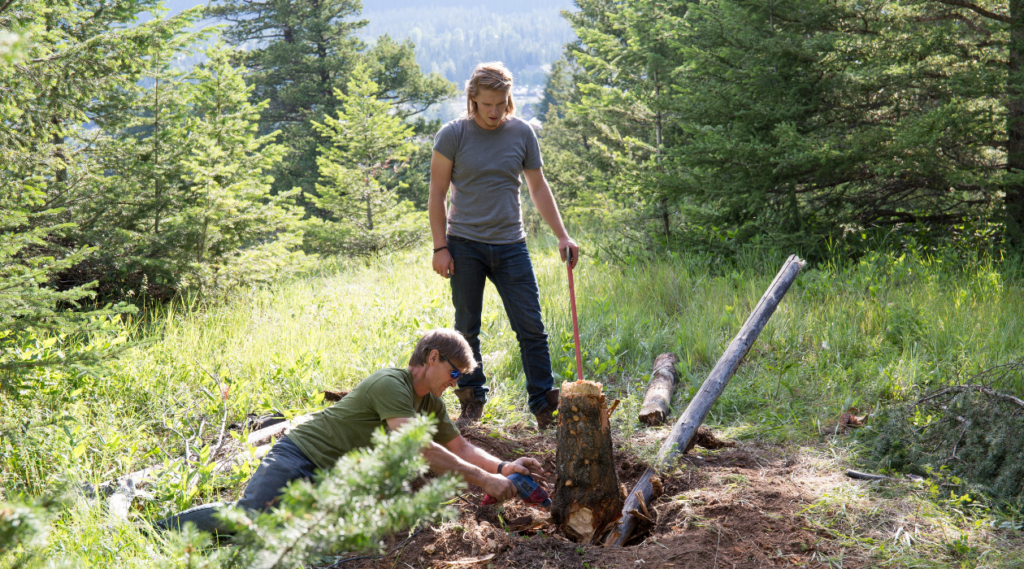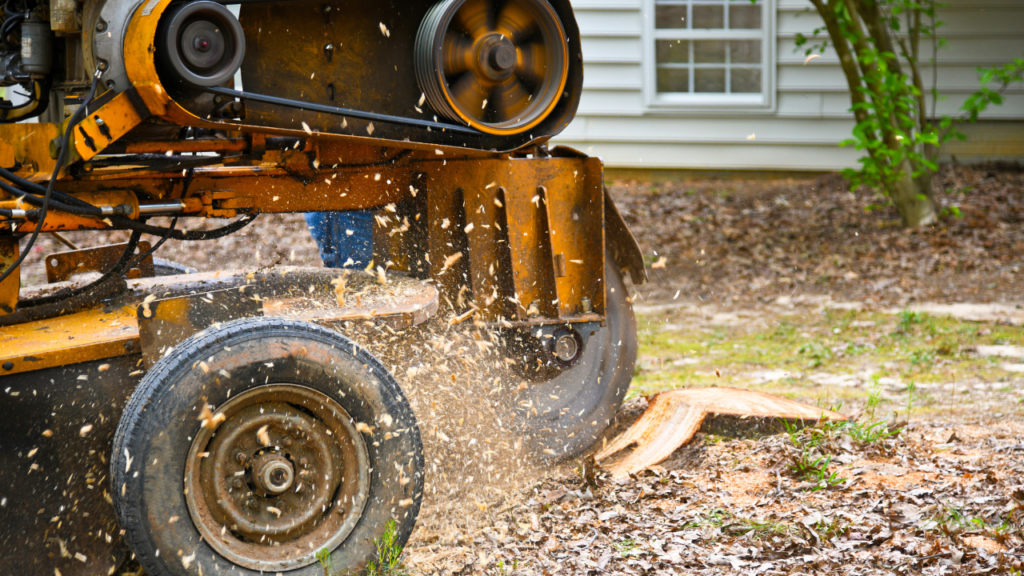After cutting down a tree in your lawn the work isn’t finished yet – stump and root removal can be just as challenging. Leaving a tree stump and root system in place after cutting down a tree isn’t just an aesthetics issue, but can cause many other problems including safety hazards or pest attraction.
In this guide we will walk you through the safest and most effective way to tackle stump and root removal, ensuring your yard is beautiful, safe, and ready for you to enjoy. Whether you’re planning to remove the stump and roots yourself or hire a professional, we’ll cover the tools, techniques, and precautions you need to get the job done right.

When is stump and root removal important?
Tree stump and root removal are important when there are safety and pest hazards involved. Leftover tree stumps can attract many pests like termites, ants, beetles, and other wood-boring insects. If left to fester, these pests can potentially spread to other healthy plants and trees in the area, or even into your home.
Leaving old tree stumps and roots in place can also cause safety hazards. Stumps and roots not only cause a tripping hazard, but root systems if left unchecked may continue to grow, potentially causing damage to foundations, sidewalks, driveways, and more.

Do-It-Yourself Stump and Root Removal: The Tools You’ll Need
You will need a variety of tools if you plan to DIY your stump and root removal process, here is a list of the most common ones:
Safety:
- Safety glasses or goggles
- Heavy-Duty Gloves
- Steel-Toed Boots
- Ear Protection
Digging & Cutting:
- Shovel
- Mattock
- Spade
- Chainsaw
- Axe and/or Loppers
Stump Removal:
- Stump Grinder
Debris Clearing:
- Rake
- Wheelbarrow
Fire Safety Tools (If Burning the Stump):
- Hose and/or Bucket of Water
- Fire Extinguisher
- Tarp

Safety First
No matter how big or small, safety should always come first in any home improvement project, and stump and root removal is no exception. Be sure to wear safety glasses or goggles when working with any equipment, wear heavy-duty gloves when handling wood or mulch, and ear protection when working with loud equipment such as the chainsaw.
Removing tree stumps and roots yourself can be a great project, however be aware of any and all safety precautions that come with working with heavy duty equipment and the cleanup required afterwards. If you find yourself in a situation where you are concerned about the safety of doing this project yourself, you can always reach out to a local arborist in your area to assist you.

Exposing the Roots
The first step to tree stump and root removal after a tree has been removed from your property is to dig around the stump to expose the roots. Exposing the roots allows you to see the size, direction, and depth of the root system so that you can determine the best plan for moving forward with removal.
A shovel is the most important tool that you will need for this step. Once you have exposed the roots, a mattock and spade can be used to loosen the dirt around roots in areas that are too small for your shovel.

Grinding the Stump
While there are other methods such as chemical removal, using a stump grinder is the fastest and most effective way to remove a stump from your yard. A stump grinder uses a rotating cutting wheel with sharp, carbide-tipped teeth. The wheel spins at sharp speeds, grinding the stump into small wood chips that can be used as mulch.
You can use a smaller, handheld stump grinder for small stumps, or rent a larger model from a home improvement store or arborist near you for larger stumps or more extensive projects. BE sure to grind the stump between 4-16 inches below the surface to allow for landscaping over the area.

Digging Up and Chopping the Roots
Now that the tree stump has been removed, it is time to move on to the root system. The best way to remove the roots is to start by digging a wide and deep trench around where the stump was to continuously expose the roots. This will allow you to easily reach the roots with a chainsaw. You can also use your mattock and spade to loosen dirt around the roots that are in areas that are too small for your shovel.
Generally the trench that you dig should be at least 12-18 inches wide and around 8-12 inches deep. However you can adjust the width and depth of the trench depending on the size of the tree that was removed.
Once they are exposed, use your chainsaw to cut through the roots. Start by cutting the larder roots closest to the stump, and be sure to use all necessary safety equipment and be aware of your surroundings when operating the saw. For smaller, harder-to-reach roots you may use an axe, loppers, or a pruning saw.

Clearing the Area and Filling the Hole
After this you are almost done! The last step after your tree stump and roots have been removed is to clear the area and fill in the remaining hole. If you ground your tree stump you can use the wood chips as mulch to help fill in the area. You can then fill the rest of the area with soil. If you are interested in reading more about how to restore your landscape after tree removal, you can check out ‘How to Restore your Landscape After Tree Removal: A Step-by-Step Guide‘.
As for clearing the area, you have lots of options. One is renting a dumpster and placing all of the debris in there. Another option is burning the debris. Burning the leftover debris can be a cost effective way to get rid of green waste, however be sure to check with your local laws first and make sure that you have all the necessary safety equipment before burning to prevent the fire from spreading to nearby objects.

Professional Tree Stump and Roots Removal
If you are interested in hiring a professional team to remove the stump and/or root system from you lawn, you can always contact a local arborist to assist you. Land Tree Removal specializes in connecting you with an arborist who will be able to help you will all of your tree and land removal service needs, all you have to do is fill out the form on our website here: https://landtreeremoval.com/request-a-quote/
DIY vs Professional
There are many factors that can help you decide if you’d like to remove a tree stump and/or root system yourself or if you’d like to hire a professional team. The size of the stump and roots that you’d like removed, how deep they go, and how many tools you already have available to you are some of the biggest. While you can save money doing it yourself, it may take longer and it may be less safe for you to complete the task than if you were to hire an arborist to complete it for you.
Stump and Root Removal
Stump and root removal can be an important part of enhancing your lawn after tree removal for many reasons, including removing safety hazards and avoiding the attraction of pests to your area. With the right tools you can remove a tree stump and roots yourself, which may save you money. However with larger jobs it may be safer and more effective to hire a professional arborist. If you have any experiences or tips to share add them in the comments below to share with others! And if you are looking for professional arborists in your area to help you with a stump removal you can fill out the Land Tree Removal Free Estimate form linked here: https://landtreeremoval.com/request-a-quote/




